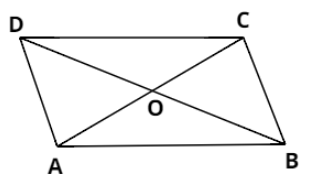
Given a parallelogram ABCD. Complete each statement along with the definition used:
$(i)$ $AD = $ $(ii)$ $\angle DCB = $ $(iii)$ $OC = $ $(iv)$ $m\angle DAB + m\angle CDA = $


Answer
606.3k+ views
Hint: Use the properties of parallelogram: Opposite sides are parallel and equal, opposite angles are equal and sum of adjacent angles is ${180^ \circ }$.
Complete step-by-step answer:
Given, ACBCD is a parallelogram with O as the point of intersection of its diagonals AC and BD.
$(i)$ We know that in parallelogram, lengths of opposite sides are equal. Hence, we can conclude that:
$ \Rightarrow AD = BC$
$(ii)$ We know that in parallelogram, measure of opposite angles is equal. Hence, we can conclude that:
$ \Rightarrow \angle DCB = \angle DAB$
$(iii)$ We know that in parallelogram, diagonals bisect each other. Hence, we can conclude that:
$ \Rightarrow OC = OA$
$(iv)$ We know that in parallelogram, adjacent angles are supplementary (i.e. their sum is ${180^ \circ }$). Hence, we can conclude that:
$ \Rightarrow m\angle DAB + m\angle CDA = {180^ \circ }$
Note: In parallelogram, although the diagonals bisect each other but their lengths are not equal.
In the above parallelogram, $AC \ne BD$.
Complete step-by-step answer:
Given, ACBCD is a parallelogram with O as the point of intersection of its diagonals AC and BD.
$(i)$ We know that in parallelogram, lengths of opposite sides are equal. Hence, we can conclude that:
$ \Rightarrow AD = BC$
$(ii)$ We know that in parallelogram, measure of opposite angles is equal. Hence, we can conclude that:
$ \Rightarrow \angle DCB = \angle DAB$
$(iii)$ We know that in parallelogram, diagonals bisect each other. Hence, we can conclude that:
$ \Rightarrow OC = OA$
$(iv)$ We know that in parallelogram, adjacent angles are supplementary (i.e. their sum is ${180^ \circ }$). Hence, we can conclude that:
$ \Rightarrow m\angle DAB + m\angle CDA = {180^ \circ }$
Note: In parallelogram, although the diagonals bisect each other but their lengths are not equal.
In the above parallelogram, $AC \ne BD$.
Recently Updated Pages
Two men on either side of the cliff 90m height observe class 10 maths CBSE

What happens to glucose which enters nephron along class 10 biology CBSE

Cutting of the Chinese melon means A The business and class 10 social science CBSE

Write a dialogue with at least ten utterances between class 10 english CBSE

Show an aquatic food chain using the following organisms class 10 biology CBSE

A circle is inscribed in an equilateral triangle and class 10 maths CBSE

Trending doubts
Why is there a time difference of about 5 hours between class 10 social science CBSE

Write a letter to the principal requesting him to grant class 10 english CBSE

What is the median of the first 10 natural numbers class 10 maths CBSE

The Equation xxx + 2 is Satisfied when x is Equal to Class 10 Maths

Which of the following does not have a fundamental class 10 physics CBSE

State and prove converse of BPT Basic Proportionality class 10 maths CBSE




